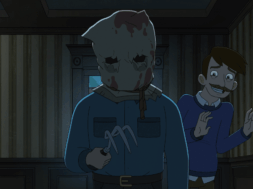The Dreamcast’s ‘Blue Stinger’ Was a Campy, Messy Attempt to Breathe New Life Into Survival Horror
We re-visit the bonkers madness of ‘Blue Stinger,’ the Dreamcast’s first and most ridiculous foray into the survival horror genre
“What will you do if the monster attacks you when you’re butt-naked?”
“Then I’ll fight back butt-naked!”
When the Dreamcast was fresh on the market, many of the examples of innovative graphics and gameplay in its titles spoke to a whole new generation of gaming that could do wonders for the survival horror genre (there’s a reason that Resident Evil CODE: Veronica was originally a Dreamcast exclusive). If titles like Resident Evil, Silent Hill, and Clock Tower could be so effective while still stuck in the 32-bit era, then imagine what could be done with the Dreamcast. The killed-too-soon Sega system has plenty of gems that fit into the horror genre, but one of the Dreamcast’s most peculiar survival horror games is a certain launch title that combines zombies, space fairies, and a location that’s inexplicably called Dinosaur Island (like seriously), all while keeping a straight face. Welcome to the world of Blue Stinger.
Blue Stinger hit the scene as one of the Dreamcast’s lesser-known launch titles. While most gamers already knew that they’d be grabbing the likes of Sonic Adventure, Soul Calibur, or Crazy Taxi with their new bliss machine, Blue Stinger was hoping that maybe someone would give it a shot because all the other more popular games were sold out. In fact, a rather interesting sales strategy was implemented with Blue Stinger’s US release. The game was actually available one whole week before the Dreamcast had even launched on 9/9/99. Take a second to consider this tactic. What benefit could this possibly serve? Did Sega and Activision hope that people would blindly buy the game simply because it was available? They couldn’t even play it yet! Thankfully the Dreamcast had a wealth of impressive launch titles because if their releases were more like Blue Stinger then the Dreamcast might have been crippled before it could even really get going. But hey, at least the game’s Japanese commercial is cool!
Blue Stinger comes courtesy of the tiny development team over at Climax Games (which would later re-brand as Crazy Games). The Crazy Games team only developed two titles—Blue Stinger and Illbleed—before they permanently shut down. Eliot’s sidekick, Dogs, even has a brief cameo in Illbleed as a corpse, which is honestly pretty fitting considering Blue Stinger’s reputation. Blue Stinger would ultimately go on to sell over 500,000 copies, but the game hardly found mainstream success or even much critical acclaim. The game’s creator and producer, Shinya Nishigaki (whose only other notable credit was the questionable Saturn title, Dark Savior) also died a few years after Blue Stinger’s release, which means that he wouldn’t go on to attempt some spiritual successor to his work. Blue Stinger was also directed by Ayumu Kojima, which was notably his first directing gig. He would go on to work on Crazy Games’ Illbleed in 2001, but that’s it.

Blue Stinger dresses itself up as survival horror, but it’s actually quite the surprising cocktail of madness. There’s a very bizarre tone and attitude to the game and there are continually weird elements throughout the experience that should make gamers do a double take, whether it’s nonsensical enemy designs, the game’s soundtrack, the fact that weapons and items are acquired through vending machines, or even just the smaller details like the title’s weird allegiance to other Dreamcast games or the fact that Eliot’s primary weapon strangely has two triggers for no reason other than the fact that it looks “cool.” That mentality I present through all of Blue Stinger and while this doesn’t necessarily amount to a scary survival horror tile or even a “good” one, it does make for a memorable, different experience that’s worth a playthrough if it doesn’t drive you mad in the process.
Blue Stinger wastes no time at all to throw as many trippy visuals at its audience as possible. The game begins on Christmas of 2017 when a meteor-like object crashes down on Dinosaur Island and Eliot and company must investigate. It’s actually kind of interesting to see the threat come from space for once and invade Earth that way rather than humans invading its environment, but that glimpse of creativity doesn’t go far enough. Pretty soon there’s a space fairy named Nephilim making out with Eliot and implanting him with her memories in the process.
The game’s sizzle reel tells the audience, “After 65 million years…the island is awake,” but it doesn’t really mean anything. It’s just exciting buzzwords. The game’s opening cutscene is maddeningly nearly ten minutes long and it really goes all out here to make this feel like an epic, next-gen experience. The fact that the game throws you right into chaos gives the impression that you’re beginning in the climax of a movie, but there’s, unfortunately, plenty of non-climax left to go.

With the game’s focus on piers, islands, and other water-based locations, it should come as no surprise that the title does involve a lot of water, which is a nice way that this game manages to feel unique from other horror games. That being said, Blue Stinger doesn’t embrace the idea as much as it could and there are other games (like the relatively ignored Sega Saturn title, Deep Fear) that go further with underwater terror. In reality, Blue Stinger embraces its horror-comedy tendencies more than anything and it results in an entertaining experience, but one that never manages to be genuinely frightening or creepy, whereas Deep Fear does achieve genuine creepiness and even Illbleed eventually has moments where absurd gore still cuts through the level of camp. This never happens in Blue Stinger.
With titles like Blue Stinger there can often be production elements that are unintentionally humorous, such as voice acting or the game’s script. Blue Stinger actually features decent vocal performances that really go all out in these roles. However, the dialogue and translation work leaves a whole lot to be desired. Furthermore, the game’s main characters, Eliot and Dogs, are voiced by Ryan Drummond and Deem Bristow, who are basically just doing their Sonic voices here. If you close your eyes it’s quite easy to trick yourself into thinking that Sonic and Dr. Eggman are having a vacation on Dinosaur Island, which is a bit of a surreal experience.
One of the definite highlights of Blue Stinger is the camaraderie between Eliot and Dogs. The game builds an effective, albeit silly, buddy cop dynamic between Eliot and Dogs. Plus, the awkward, sexist banter with the team’s resident female, Janine, is also rather ridiculous and plays into the genre. At one point in the game Eliot and Dogs decides to take a bath together like this is a hot springs filler episode of an anime. Not Eliot, Dogs, and Janine. Just Eliot and Dogs. This scene justifies itself with the lame excuse that now the monsters won’t be able to smell them. It’s also bookended by some questionable dialogue like, “I’m gonna take a bath. Nothing’s gonna stop me!” Eliot and Dogs proceed to get into a rather lengthy conversation about how cool it is to take a bath in the middle of an emergency and that they’ll even fight naked, if they have to! Well, that’s something that Chris Redfield and Leon Kennedy have never had to do together in a Resident Evil game so far… If all of this wasn’t enough, Blue Stinger’s grand prize for completing the game under the most stringent of restrictions is the bizarre “Swimsuit Mode,” which allows people to play through the game again as scantily clad versions of Eliot and Dogs. This is hardly strong incentive to play through the game again, but at least Blue Stinger seems to be in on the joke.

The rest of the game’s sound and music design is equally all over the place, but the music is at least composed by Toshihiko Sahashi of Gundam SEED fame. There are also only six tracks in the game that play ad infinitum while other “clever” tricks are used to extend music and remix audio stingers. The music is definitely a little overdramatic, but it’s not at all creepy or suspenseful. In fact, it’s basically Christmas music on speed. By the end of the game, your brain will be a constant echo chamber of the seasonal track, “Lab Town.” The Dreamcast’s slogan was, “It’s thinking,” but in this case, it’s definitely screaming.
Another particularly curious decision that Blue Stinger makes involves the game’s controls and camera angles. The Western version of the game actually forces an awkward behind-the-character third-person camera perspective, which becomes quite erratic at times. However, Blue Stinger’s Japanese release uses a fixed camera angle, like the popular Resident Evil, and it’s a little more manageable, but prone to its own set of frustrations. Players can often get stuck in a door jam or other badly angled situations where Eliot is forced to blindly fire into the abyss. That being said, it is interesting to see that this game tried to adjust its camera based on its audience, but the better strategy would have been to offer both options in both versions of the game.
While Blue Stinger’s aesthetics may have players scratching their heads in confusion, there are at least some fairly outrageous, creative enemy designs in the game. Blue Stinger’s monsters really go above and beyond and they all look like chimera-esque abominations. This naturally leads to some rather inventive boss battles and by the end of the game you’re basically fighting dinosaur-like obstacles. Attacking these creatures also results in gallons of blood in an attempt to seem “scary.” These enemies alone make Blue Stinger feel different than the standard survival horror fare where uninspired enemies like zombies are the norm. What other horror game has a giant blob for an enemy? We need more blob representation in survival horror titles! Blue Stinger again shows its personality and its clear sense of humor here, like how zombies dress up in Santa outfits, there’s a boss that looks like a hermit crab beast that uses a jeep as its shell, and its weird obsession with a cutesy mascot who continually pops up.

In addition to the game’s enemies, there is also a nice variety of weapons in Blue Stinger, which includes some badass additions to Eliot’s arsenal, such as acid, plasma, ray, and rail guns! There’s even a bazooka that’s fun as hell to let loose with when you really don’t give a damn anymore. Additionally, there’s an extensive list of atypical handheld weapons like a stun rod, ray sword (every game needs a lightsaber clone), iron knuckles, and more. It’s quite detailed and allows the user a surprising amount of customization. Another truly bizarre detail is that the game’s weapons and ammo come out of vending machines and somehow pistol ammo costs less than a TV dinner or an 80 dollar sandwich. But who are we to question this? Who knows what life is like in this neo-dystopia of 2018! Hassy is also the Blue Stinger universe’s beverage of choice. Hassy.
In terms of the game’s level design, the “big city” and mall plaza areas where Christmas lights and electricity bombard the player are really a sight and they speak to the Dreamcast’s impressive capabilities at the time. There’s also a certain thrill from killing monsters in a brightly lit supermarket with Jingle Bells blaring in the background. Blue Stinger’s levels push a very cyberpunk look, but there are still plenty of creepy and inconsistent textures on characters and locations. This doesn’t feel like it’s specifically an artistic choice as much as it’s just a clashing of styles that happens to somehow work out in a weird way. It does help that all of Blue Stinger’s environments are completely 3D rather than pre-rendered, but the possible routes to explore are sometimes comically telegraphed and the space to travel is actually much more limiting than it may initially appear. While on this topic, there’s a perplexing room in one of the game’s convenience stores that’s full of pornography and the game even asks players if they’re over 21 before gaining access to the room. This hidden area is only in the Japanese release and scrubbed from the US version, but why put that in this game out of all the possible options?
As Eliot navigates through these levels, there’s a whole lot of keycard tag present, at least in the first quarter of the game. There’s a lot of going to a location, finding a locked door, then finding the new key card. However, one instance of this becomes a bizarre crossover with the obscure Dreamcast creature racer, Pen Pen Trilcelon. This isn’t an added bonus like the toy capsules in Shenmue or something. You actually need to require four Pen Pen stamps to progress in the game and it’s just so weird. Imagine if in order to unlock a door in Resident Evil 2’s police station you needed four Mega Man magnets, or if entry to Silent Hill’s school is allowed after Harry Mason presents the nurse with three Metal Gear Solid figures? What’s even worse is Pen Pen Trilcelon doesn’t even return the favor! You’d think there would at least be a track set on Dinosaur Island or a Blue Stinger-themed vehicle, but nope. It’s almost like it doesn’t want to invite the association.

In addition to this, there are also strange attempts at block buzzles and timed events, which will reward Eliot with new weapons, but none of this is actually necessary. While they can make for interesting distractions, these sections feel more like something from out of a Zelda or Tomb Raider game than a survival horror title. Plus, there are also random civilians that can be helped and saved throughout the game. This is a little evocative of House of the Dead’s style and even though this material is not fundamental, it still adds a nice added level of difficulty to the experience. Blue Stinger also expands these timed events into more substantial sequences. There are several real-time missions, which seem like they could build suspense, but they’re just excruciatingly long! One of these missions puts 42 minutes on the clock as Eliot tries to get a dying man his medication and another gives Eliot a full half hour to keep himself from mutating into a monster.
Blue Stinger does deserve some credit for the ambitious decision to let Eliot get infected and start to transform into a monstrosity around the game’s mid-way point. However, this surprise isn’t just for shock value and Eliot actually gain the ability to crawl on ceilings and behave like a monster, which definitely makes for a creative second act. Resident Evil has played around with its protagonists getting infected, but it usually results in them out of commission while their partner hunts for an antidote. Wouldn’t it make for a nice change if one section in a Resident Evil game actually has your character act like a zombie and see with impaired vision? Behind all of the camp and silliness, Blue Stinger actually contains some strong gameplay ideas. It’s just a shame that the culmination of all of these parts is something that’s this insane. The game’s final boss turns into a showdown of sorts that seems more appropriate for the finale of Neon Genesis Evangelion than anything else. It’s quite the incomprehensible piece of space fairy nonsense and it’s even arrogant enough to anticipate that people would want a sequel to this “cliffhanger.” It’s more of an existential disaster than something that makes you hungry to play more. It’s a resounding Huh? rather than an impressive Woah!
With Blue Stinger, it’s really just one absurd set piece after another, whether it involves meeting someone new who has a bizarre disposition given the life-threatening situation at hand, or some new scenario that requires a ridiculous task of Eliot. This is all so prevalent and in your face that it’s just best to get on board with it from the start rather than fight it. Sure, you won’t get scared, but you can tear up jeep-crabs with a laser sword, so the glass of Hassy is still half full here. Crazy Games would ultimately get a lot better with this formula in their next and final title, Illbleed, but part of Blue Stinger’s charm is in how flawed and inexplicable so much of it is.
Much like many of the more obscure titles on the Dreamcast and Sega Saturn, there, unfortunately, isn’t a way to play Blue Stinger besides on the Dreamcast (but it’s woefully cheap if you do have the system). This isn’t the sort of title that has as rabid of a fanbase as something even as small as Deep Fear, so it’s unlikely that this will pop up on Steam or GOG.com any time soon. That being said, if the rights could be sorted out, a combo-pack of Crazy Games’ complete library that features both Blue Stinger and Illbleed would make for an appealing item. Collectively these titles represent a weird corner of the survival horror genre and it’s a perspective that’s worth revisiting after how serious things can get in horror games.
God, somebody give me a Hassy. I need a drink.












